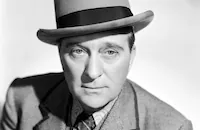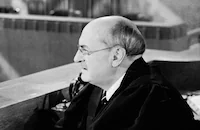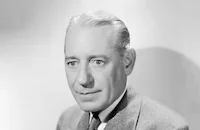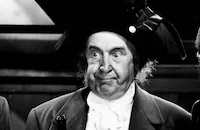Midnight
Brief Synopsis
Cast & Crew
Chester Erskine
Humphrey Bogart
Henry Hull
Sidney Fox
O. P. Heggie
Richard Whorf
Film Details
Technical Specs

Synopsis
Ethel Saxon confesses in court to the murder of her errant husband John in a "crime of passion," and also admits she took his money. Jury foreman Edward Weldon, who believes in obeying the letter of the law, convinces his peers to convict Ethel of first degree murder, despite public sympathy for her cause. On the day of her execution, reporter Bob Nolan bribes idle Joe "LeRoy" Biggers, Weldon's son-in-law, to get him into the Weldon home to see the family's reaction as Ethel is taken to the electric chair. Weldon's daughter Stella has fallen in love with gangster Gar Boni, whom she met at the trial, but that night he tells her he is leaving for Chicago. Learning that he is a gangster only makes Stella more desperate to keep Boni, and she becomes determined to see him before he leaves town. Meanwhile, Ethel's lawyer, Edgar V. Ingersoll, asks Weldon for help in mounting an appeal, but is rejected. Just before the execution, Stella abruptly leaves to say goodbye to Boni, who admits, to her consternation, that their relationship is over. At the same time that Ethel is taken to the chair and the switch is thrown, a shot is fired in the Weldon house. After Nolan reveals his identity and has the family photographed, Weldon steps onto his porch and tells the waiting crowd that murder must be punished. Stella enters, dazed, and announces that she has shot Boni with his own gun. Nolan offers to help, but Weldon insists that the law must be followed and telephones District Attorney Plunkett, the prosecutor in Ethel's case. Before Plunkett questions Stella, Nolan reminds Weldon of how the headlines would read if Stella is found to be a murderer. Plunkett discovers that although Stella only remembered firing one shot, three bullets are missing from Boni's gun. Plunkett dismisses Stella's confession as the product of a nervous condition and speculates that Boni's murder was a gangland killing, that may never be solved.

Director
Chester Erskine
Cast

Humphrey Bogart

Henry Hull
Sidney Fox

O. P. Heggie

Richard Whorf

Lynne Overman

Granville Bates

Cora Witherspoon

Margaret Wycherly
Moffat Johnson

Henry O'neil
Helen Flint
Katherine Wilson

Dudley Digges
Crew
Jack Aichele
Chris Bute
Sam Corso
Arthur Cozine
Arthur Cozine
Ray Cozine
Danny Doran
John Doran
Chester Erskine
Chester Erskine
Ed Frarity
George Popovici
Eddie Senz
William Steiner
Frank Surjack
C. A. Tuthill
Frank Tuttle
George Webber
Leo Zochling

Film Details
Technical Specs

Quotes
Trivia
Notes
Chester Erskine marked his directorial debut in the film. The above credits are from a re-issue print and May not accurately reflect the order of the original credits; contemporary reviews list Humphrey Bogart eighth with Sidney Fox and O. P. Heggie getting top billing. News items in Film Daily credit Ray Cozine as Erskine's co-director, not assistant director as he is credited onscreen. The Motion Picture Herald review called Midnight an adult picture and a tragedy. Bogart and Sidney Fox had previously appeared together in Universal's 1931 picture, The Bad Sister. Midnight was subsequently re-released as Call It Murder by Guaranteed Pictures Co., Inc., with Humphrey Bogart's name appearing above the title. Modern sources add that Screen Guild reissued the picture on September 13, 1947.

Miscellaneous Notes
Released in United States 1934
Released in United States 1934











